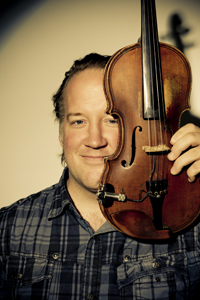Today's guest blog is from teacher and violinist Christian Howes. Mr. Howes shares some great advice for musicians: make friends with someone who, through their background or training or experience, has something to teach you. Often we gravitate toward folks who play like us, but Mr. Howes suggests that seeking out different musical traditions challenges us and makes us less insular musicians. It's certainly an inspiring blog, but at the very least don't miss the video of the jam session below! Think about your best friends.
Think about your best friends.
Chances are they are very different from you. Your relationships bring out those differences. Like mirrors, they show you for all the good and bad, helping you grow.
If you are a classically trained musician, especially a string player or aspiring jazz violinist, and if you want to learn to groove, I strongly suggest you make friends with the rhythm section!
No doubt, classical musicians endure some of the most rigorous training, developing an incredible range of nuance when it comes to phrasing, style, articulation, rhythm, intonation, sound color, and more. Nonetheless, one thing they do not generally learn is how to groove!
Drummers on the other hand spend at least half of their practice time and energy working on groove/swing, aka “time feel.”
Someone once told me the best way to learn Spanish is to meet a Spanish girlfriend and move to Spain. Sure, you can take classes or read books, but there’s nothing like living in a country with natives to get a real grip on the language.
Rhythm section players swing better and groove better than me so I constantly try to surround myself with good rhythm section players to improve. We all know that we get better by playing with people better than us.
If you’re a classical musician, chances are you may not know a lot of rhythm section players, so here’s a suggestion:
Go to a local jazz jam session or observe some college jazz classes.
Introduce yourself to some of the bass players, piano players, guitar players and drummers.
Ask them if they would be willing to get together and play sometime.
Offer to buy them lunch or even offer some money and treat the meeting as a lesson.
You can play over tunes, grooves and vamps, or just improvise free.
Record yourself and listen back. Make notes about what you like and what you don’t like. Ask the rhythm section player for honest feedback about your “time feel.”
In this video my friend Cedric Easton plays drums. We improvise free, performing live for little kids at an elementary school while they paint pictures to the music. We had no idea what we were going to play beforehand.
Cedric is a “time feel” expert: I’ll never swing as hard as he does – playing with him keeps me humble, and I know it’s helped me improve my sense of time and groove.
I think the idea of classically trained musicians reaching out to grooving drummers makes sense on a larger level too. The classical music academy is largely guided by adherence to the “Western European Canon,” i.e. centuries of thinking about music from a European perspective, which puts melody and harmony above rhythm. Jazz (and really all modern popular American music) borrows heavily from African music, which holds up the groove at the forefront. Part of the reason jazz studies departments and classical music departments can’t get along is because they’re all scared to try to understand each other’s differences and learn from them. They self-segregate in their own insular cultures of learning. Some day it would be nice if “black” and “white” music weren’t separated into ritzy theaters versus dingy clubs, and music students could simply study “music” in college, instead of choosing sides.
Don’t live in a bubble. A drummer is a jazz violinist’s best friend. Go out to the other side of the railroad tracks and make friends. You’ll be amazed by how much you grow.
——————–
If you’re a classically trained musician, especially a string player, check out Christan Howes's free trial at the Creative Strings Academy where you can develop improvisation skills in different styles of music. Click here to learn more:


